When we think about creating the perfect gathering space in our homes, traditional living rooms continue to captivate us with their timeless elegance and warm sophistication. There’s something undeniably comforting about classic design elements that have stood the test of time – rich wood finishes, plush fabrics, and carefully curated furniture pieces that tell a story.
We’ve discovered that traditional living rooms aren’t just about following old rules; they’re about creating spaces that feel both refined and genuinely welcoming. These rooms seamlessly blend comfort with style, offering the perfect backdrop for family gatherings, intimate conversations, and quiet evenings at home.
Whether you’re starting from scratch or looking to refresh your current space, we’ll guide you through proven traditional design ideas that transform ordinary living rooms into extraordinary havens. From selecting the right color palette to choosing furniture that balances form and function, these timeless approaches will help you create a living room that’s both beautiful and livable.
Create a Warm Foundation With Classic Color Palettes
Traditional living room colors set the stage for elegant comfort and lasting appeal. We’ll explore how the right palette creates depth and sophistication in your traditional living space.
Rich Earth Tones and Deep Jewel Colors
Burgundy walls create instant drama and warmth in traditional living rooms, especially when paired with cream trim and gold accents. We often recommend deep forest greens for their ability to ground a space while maintaining the classic elegance that traditional design demands.
Sapphire blues work beautifully as accent colors through throw pillows, curtains, and upholstery fabrics in traditional settings. Navy blue sofas anchored with warm wood coffee tables and brass hardware create sophisticated focal points that never go out of style.
Emerald green dining chairs or accent walls bring richness without overwhelming smaller traditional living areas. We’ve seen stunning results when homeowners combine deep plum with cream and gold for a truly regal traditional color scheme.
Timeless Neutral Combinations
Cream and taupe combinations form the backbone of many successful traditional living room designs, providing versatility for both formal and casual entertaining. We recommend starting with warm white walls and layering in beige furniture pieces to create depth without stark contrasts.
Soft grays paired with warm browns create sophisticated neutral palettes that highlight traditional furniture details like carved wood legs and tufted upholstery. Ivory and champagne tones work particularly well in traditional living rooms with abundant natural light.
Mushroom gray sofas complemented by cream walls and natural wood accents strike the perfect balance between contemporary comfort and traditional elegance. We often suggest adding texture through neutral throw blankets and pillows in linen or wool fabrics.
Incorporating Traditional Wallpaper Patterns
Damask patterns in subtle tones add texture and visual interest to traditional living room accent walls without overwhelming the space. We recommend using traditional wallpaper on one feature wall while keeping other walls in coordinating solid colors.
Toile patterns work exceptionally well in traditional living rooms, especially in classic blue and white or cream and burgundy color combinations. Floral wallpapers with small to medium scale prints create charming focal points behind traditional sofas or reading nooks.
Striped wallpapers in traditional color palettes like navy and cream or forest green and gold add height and elegance to traditional living rooms with standard ceiling heights. We suggest pairing patterned wallpaper with solid colored traditional furniture to maintain visual balance throughout the room.
Choose Elegant Traditional Furniture Pieces
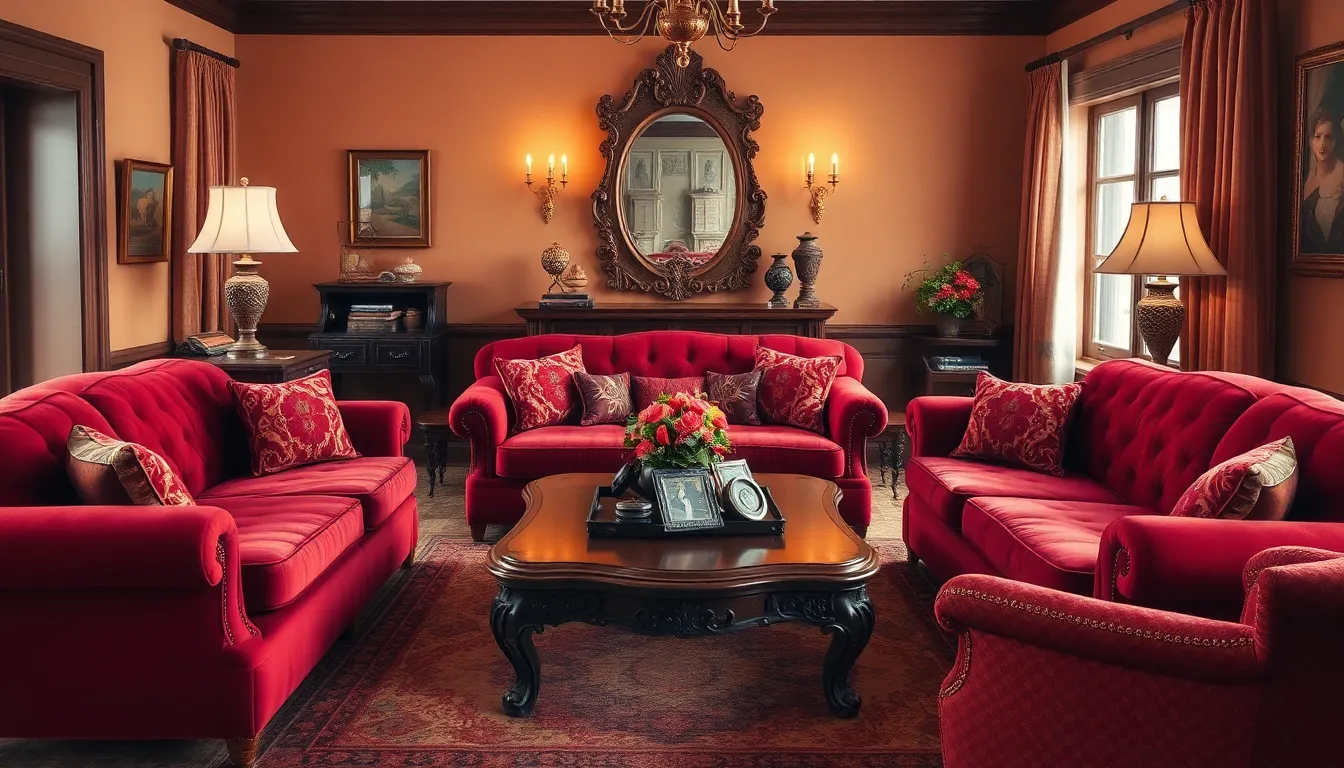
Now that we’ve established our color foundation, let’s focus on selecting furniture pieces that embody traditional elegance and comfort.
Selecting the Perfect Sofa and Seating Arrangements
Start with a comfortable, plush sofa as your room’s anchor piece. Traditional sofas feature generous upholstery with curved lines that invite relaxation. We recommend choosing pieces with soft, rounded edges rather than sharp, angular shapes to maintain that classic traditional aesthetic.
Complement your main sofa with matching armchairs or aged leather chairs. These additional seating options create layers of comfort while maintaining visual harmony. Rich tones such as deep reds, greens, blues, and mustards work beautifully for upholstery, adding richness and timelessness to your space.
Arrange your seating in symmetrical groupings to promote conversation. We suggest creating wrap-around formats that encourage social interaction while reinforcing the balanced layout that traditional style demands. This symmetrical approach creates visual harmony and makes your living room feel both formal and welcoming.
Adding Classic Wood Coffee Tables and Side Tables
Classic wood coffee tables serve as essential traditional furniture elements. We recommend selecting pieces with elegant carved details or turned legs that enhance the antique feel. These distinctive features add character and showcase the craftsmanship associated with traditional design.
Choose wood finishes that display natural grain and patina for authenticity. Weathered or distressed furniture pieces, particularly those with worn wood surfaces, enhance the character and charm of your traditional living room. This aged appearance adds depth and history to your space.
Coordinate side tables near your seating areas for both convenience and balanced composition. We suggest placing these functional pieces strategically to create symmetrical arrangements while providing practical surfaces for lamps, books, and decorative objects.
Incorporating Antique or Vintage Accent Pieces
Accent your room with antique mirrors featuring gold or brass intricate detailing. These reflective pieces add grandeur and help distribute light throughout your space. We recommend choosing mirrors with ornate frames that complement your furniture’s rich tones.
Use vintage candlesticks, chandeliers, and ornate lighting fixtures for refined elegance. These lighting elements serve as both functional and decorative features, creating ambiance while showcasing traditional craftsmanship. Brass and bronze finishes work particularly well in traditional settings.
Consider incorporating vintage coffee tables or side tables with distinctive character. These pieces add layers of history and texture to your room. We suggest mixing different wood tones and finishes to create visual interest while maintaining the overall traditional aesthetic.
Install fireplace surrounds in stacked stone or smooth stone inspired by historical styles. These architectural elements serve as excellent focal points and anchor your traditional living room design. Stone surrounds add sophistication and create a natural gathering point for family and guests.
Layer Luxurious Textiles and Fabrics
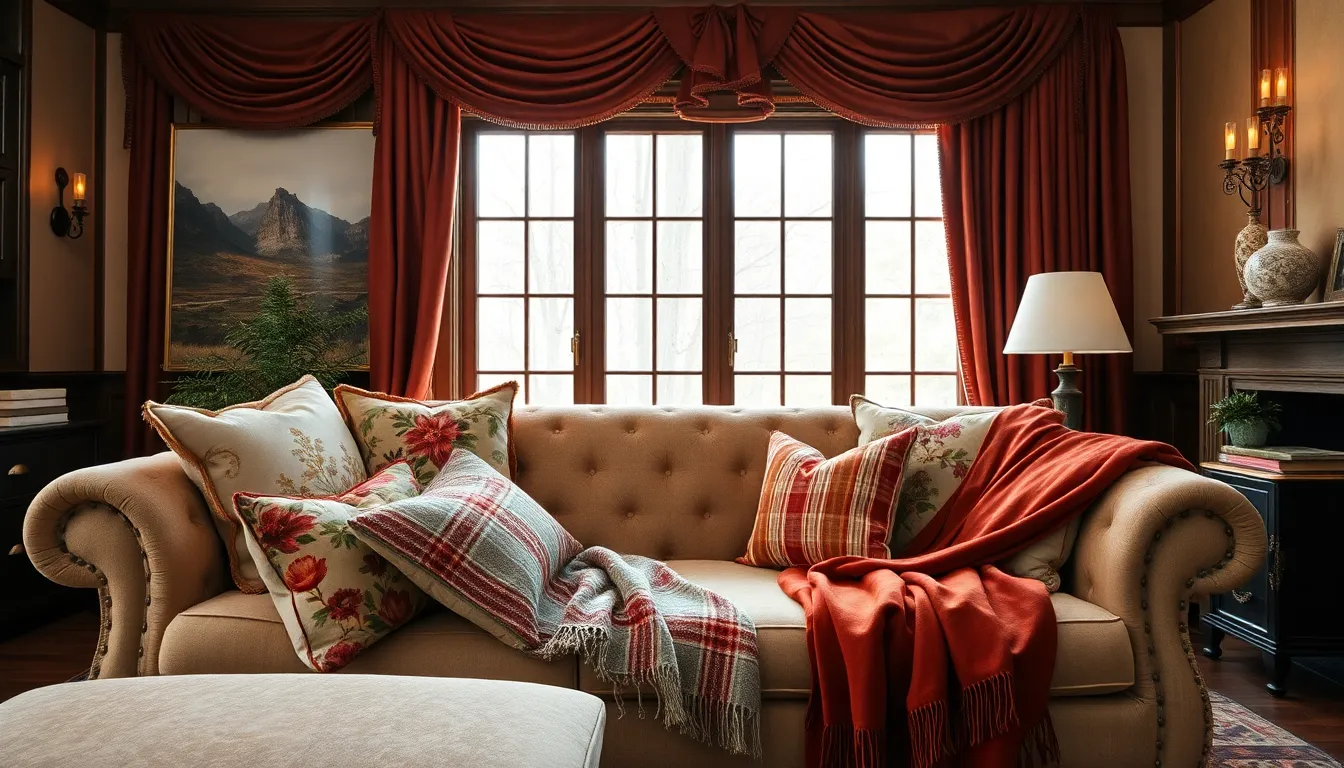
Creating depth and warmth in traditional living rooms requires thoughtful layering of rich fabrics and textures. We’ll explore how combining various materials and patterns transforms ordinary spaces into elegant, inviting environments.
Traditional Upholstery Materials and Patterns
Quality materials form the foundation of traditional upholstery choices. Leather provides timeless sophistication, particularly when it’s distressed to showcase natural patina and character. Cotton and linen offer durability while maintaining classic appeal for sofas and armchairs.
Patterns play a crucial role in establishing traditional aesthetics. Chintz brings botanical elegance to seating pieces, while paisley adds intricate visual interest. Toile patterns create storytelling elements on upholstery, and damask introduces luxurious texture through its woven designs. Floral motifs remain quintessential for traditional furniture, offering organic beauty that complements rich wood finishes.
Tufted and button back detailing elevates upholstery refinement. These classic techniques add dimensional interest to chairs and sofas while reinforcing the sophisticated craftsmanship associated with traditional design. Brocade fabrics work particularly well for accent chairs, providing rich texture that catches light beautifully.
Adding Throw Pillows and Blankets
Multiple throw pillows create inviting comfort on traditional seating. Coordinating patterns like stripes mixed with florals add visual variety without overwhelming the space. Contrasting designs work effectively when they share similar color palettes, maintaining harmony while introducing personality.
Wool blankets provide both warmth and textural appeal. Draping these luxurious materials over sofa arms or chair backs creates casual elegance that invites relaxation. Faux fur throws add tactile richness, particularly effective during colder months when comfort becomes paramount.
Strategic placement enhances the welcoming atmosphere. Arranging pillows in odd numbers creates natural visual balance, while varying sizes adds dimensional interest. Folded blankets placed within easy reach encourage guests to settle in comfortably, reinforcing our traditional living room’s hospitable character.
Choosing Classic Window Treatments
Heavy drapes with ornate rods establish traditional window elegance. Velvet and silk fabrics provide excellent light control while adding luxurious texture to walls. Lined fabrics ensure durability and improve the drapes’ ability to regulate room temperature and lighting conditions.
Decorative hardware complements the overall traditional aesthetic. Finials in brass or bronze add sophisticated finishing touches to curtain rods. Ornate brackets support heavier fabrics while contributing to the room’s elegant character through their detailed craftsmanship.
Layered window treatments offer versatility and visual interest. Roman shades with subtle patterns work beautifully underneath flowing curtains, providing privacy options while maintaining decorative appeal. Valances and swags add architectural interest above windows, creating symmetrical arrangements that reinforce traditional design principles.
Install Statement Lighting Fixtures

Lighting transforms the atmosphere of our traditional living room and serves as both functional necessity and decorative art. We’ll explore elegant fixture options that enhance the classic aesthetic while providing proper illumination for every activity.
Crystal Chandeliers and Traditional Pendant Lights
Crystal chandeliers create the ultimate focal point for traditional living rooms with their intricate designs and sophisticated sparkle. These classic fixtures add elegance and grandeur to any space while reflecting light beautifully throughout the room. We recommend selecting chandeliers that feature ornate metalwork in brass, bronze, or aged finishes to complement other traditional elements.
Traditional pendant lights work perfectly alongside chandeliers to provide additional task lighting without compromising the cohesive design scheme. Position these fixtures over reading areas or accent tables where focused illumination enhances functionality. Choose pendant styles that echo the chandelier’s design elements for visual harmony across the entire space.
Proportion plays a crucial role when selecting statement fixtures for our traditional living rooms. Ensure chandeliers and pendants match the room’s scale to avoid overwhelming smaller spaces or appearing inadequate in larger areas.
Table Lamps With Classic Shades
Table lamps deliver essential task lighting while contributing to the room’s traditional character through carefully chosen shades and bases. Classic lamp shades in fabric materials like silk, linen, or pleated paper create soft, diffused light that enhances the warm atmosphere. We suggest selecting shades in neutral tones or rich colors that coordinate with existing textiles and wall treatments.
Lamp bases offer opportunities to reinforce traditional design themes through materials like carved wood, ceramic, or polished metal. Position these lamps strategically on side tables, console tables, and accent surfaces to provide reading light and ambient illumination where needed most.
Matching pairs of table lamps create symmetrical balance that’s fundamental to traditional room design. Place identical lamps on either side of sofas or flanking fireplace mantels to establish visual order and enhance the classic aesthetic.
Creating Ambient Lighting With Sconces
Sconces provide versatile accent lighting that highlights exact architectural features and artwork throughout our traditional living rooms. These wall-mounted fixtures create soft ambient glow without taking up valuable surface space on tables or floors. We recommend installing sconces at strategic points around the room to eliminate harsh shadows and maintain consistent illumination.
Wall sconces work exceptionally well for highlighting paintings, mirrors, or built-in bookcases that showcase traditional room elements. Choose fixtures with classic designs featuring fabric shades or frosted glass that complement the overall decorative scheme. Bronze, brass, or pewter finishes enhance the traditional aesthetic while providing durable, timeless appeal.
Ambient lighting from sconces helps create layers of illumination that make traditional living rooms feel warm and inviting during evening hours. Install dimmer switches to control brightness levels and adapt the lighting to different activities and moods throughout the day.
Display Classic Art and Decorative Elements
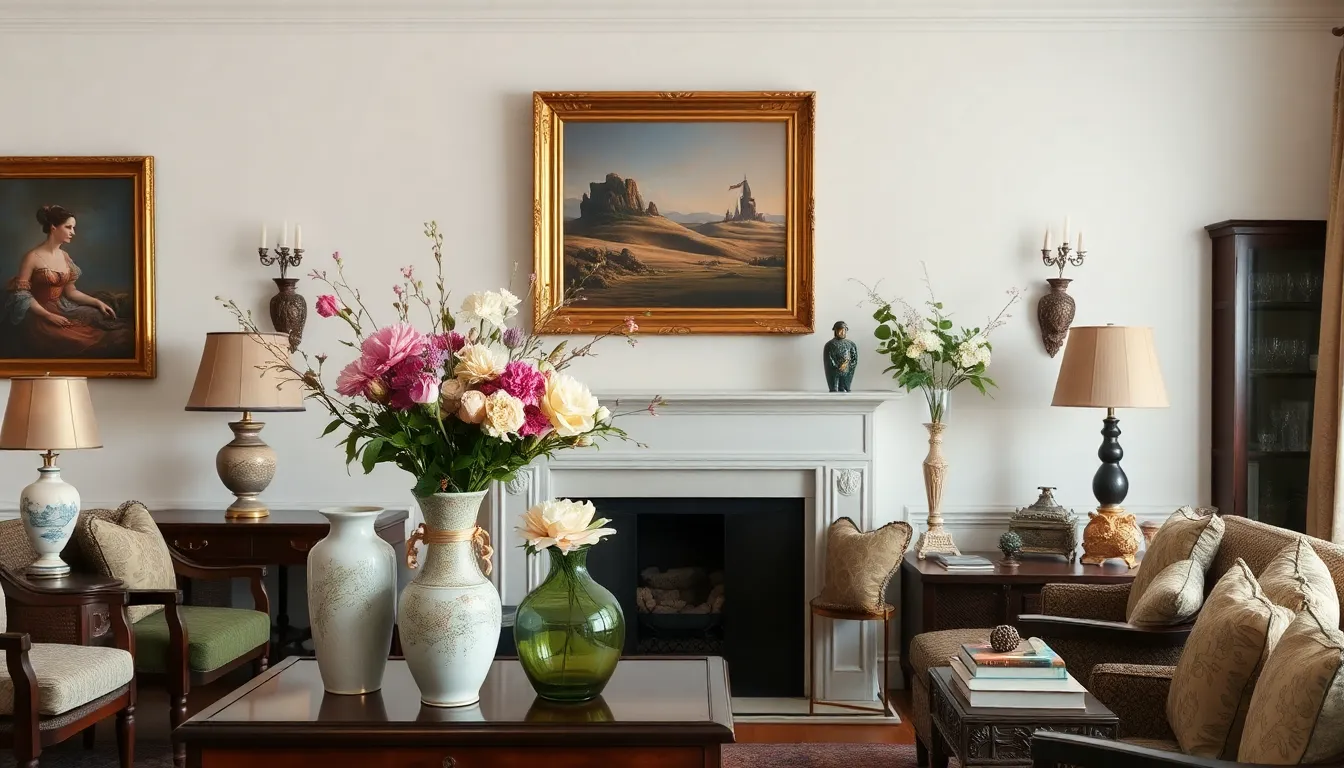
Traditional living rooms thrive on rich visual layers and curated decorative elements that reflect both sophistication and personal taste. We’ll explore how to incorporate classic art pieces and decorative elements that enhance your space’s timeless elegance.
Traditional Paintings and Framed Artwork
Formal artwork serves as the foundation for creating visual focal points throughout your traditional living room. Choose pieces with ornate wood or gilded frames that echo the classic aesthetic you’ve established with your furniture and color palette. Paintings featuring landscapes, portraits, or still life compositions work beautifully in traditional settings.
Arrange your artwork symmetrically to reinforce the balanced, harmonious feel typical of traditional interiors. Place larger pieces above your fireplace mantle or on prominent walls where they can command attention without overwhelming the space. Smaller framed prints can be grouped together in curated gallery walls that tell a cohesive visual story.
Consider the scale of your artwork in relation to your furniture pieces. A substantial painting above your sofa should span roughly two-thirds of the furniture’s width to maintain proper proportional balance.
Incorporating Family Heirlooms and Collectibles
Family treasures bring unique character and personal history to your traditional living room design. Display antique candle holders, vintage figurines, or cherished keepsakes on your classic wood side tables and built-in shelving. These items resonate with traditional style’s emphasis on layers of history and refinement.
Create dedicated display areas that showcase your collections without creating visual clutter. Use your coffee table’s lower shelf or decorative bookends to highlight special pieces while maintaining functionality. Consider rotating seasonal collections to keep your displays fresh and captivating throughout the year.
Group items in odd numbers when possible, as this creates more ever-changing visual interest than even arrangements. Mix different heights, textures, and materials within each grouping to add depth and storytelling elements to your room’s overall decor scheme.
Adding Fresh Flowers and Traditional Vases
Fresh floral arrangements bring life and natural beauty to your traditional living room’s refined atmosphere. Select classic ceramic, porcelain, or glass vases with traditional patterns or elegant shapes that complement your existing decorative elements. Crystal vases work particularly well with your statement lighting fixtures.
Position your floral displays on coffee tables, side tables, or fireplace mantles where they can add color and organic texture to the space. Choose flowers that coordinate with your established color palette while introducing subtle seasonal variations throughout the year.
Consider the height of your arrangements to ensure they don’t obstruct conversation or sightlines across your seating areas. Low, sprawling arrangements work well for coffee tables, while taller displays can anchor console tables or accent empty corners with natural elegance.
Design a Focal Point With a Traditional Fireplace
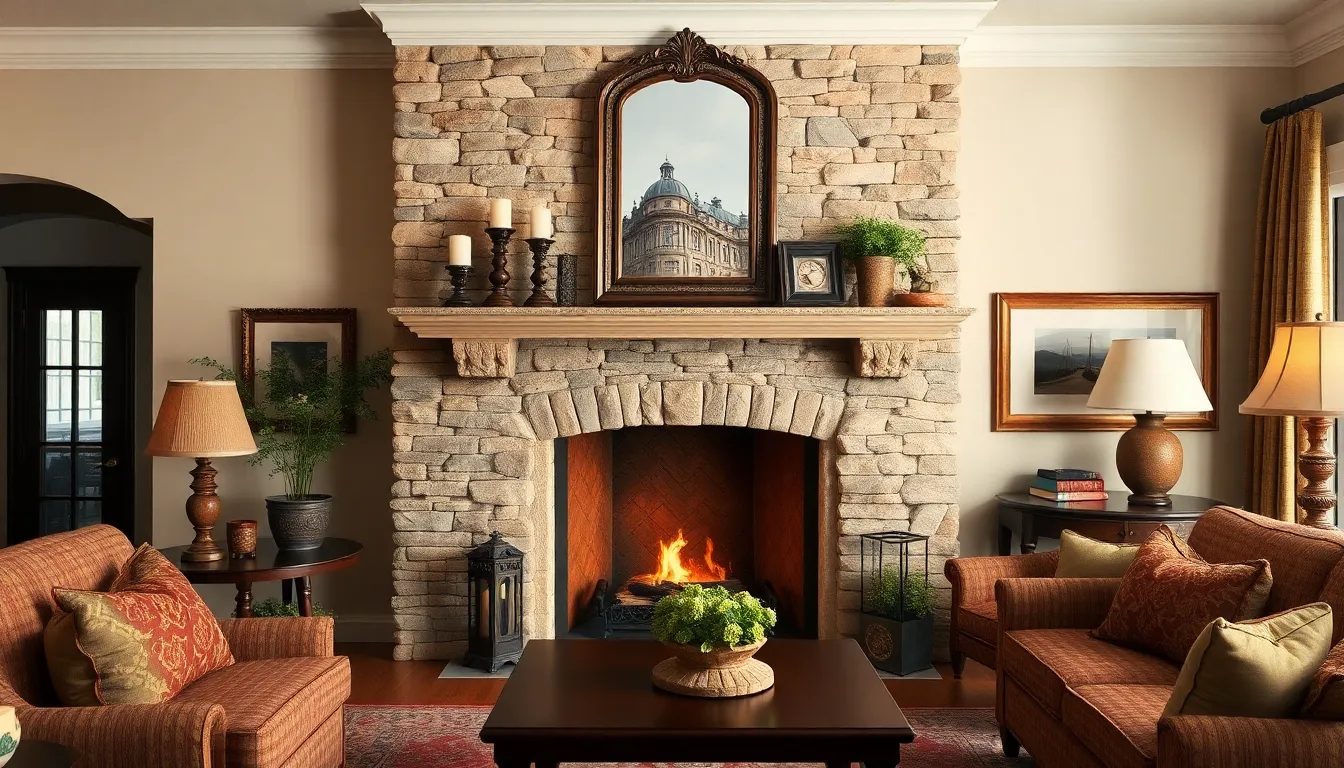
Traditional living rooms naturally center around fireplaces, making them ideal focal points that anchor the entire space. Bold design elements like stacked stone surrounds or smooth classic stone masonry enhance the room’s traditional character while evoking a sense of history and permanence.
Mantelpiece Styling Ideas
Mantelpieces offer prominent display areas that deserve thoughtful attention in traditional living room design. Grouping framed artwork creates visual impact when combined with family photos or antique mirrors featuring intricate detailing. These elements add elegance and grandeur to the space while maintaining the classic aesthetic we’re aiming for.
Layering accessories like candle holders, sculptural pieces, and seasonal decorations creates visual interest and depth on your mantel. Balancing items symmetrically on either side maintains the classic, orderly appearance that defines traditional design. Consider adding a decorative clock or vintage inspired candelabra as finishing touches that enrich the timeless atmosphere.
Choosing Classic Fireplace Accessories
Selecting fireplace accessories that complement traditional aesthetics requires attention to both function and style. Antique fire screens, brass or wrought iron tools, and ornate log holders serve practical purposes while improving the historic appeal of your fireplace. These classic elements reinforce the traditional character we’ve been building throughout the room.
Quality materials like brass and wrought iron offer durability while contributing to the sophisticated look traditional living rooms demand. Ornate detailing on log holders and tool sets adds visual interest without overwhelming the space. Consider the finish and patina of these accessories to ensure they harmonize with other metal elements in your room.
Alternative Focal Points for Rooms Without Fireplaces
Living rooms lacking fireplaces can still achieve strong focal points through strategic furniture placement and design choices. Large statement pieces like grand armoires, bookcases, or console tables serve as natural anchors for the space. These substantial pieces provide the visual weight necessary to ground your traditional living room design.
Mounting large mirrors, particularly those with gold or brass frames, above console tables adds visual impact while reflecting light throughout the room. Another effective approach involves arranging seating around striking coffee tables or prominently displayed artwork. This arrangement ensures your room maintains the sense of symmetry and traditional balance we’ve emphasized throughout our design approach.
Incorporate Built-In Storage and Bookshelves
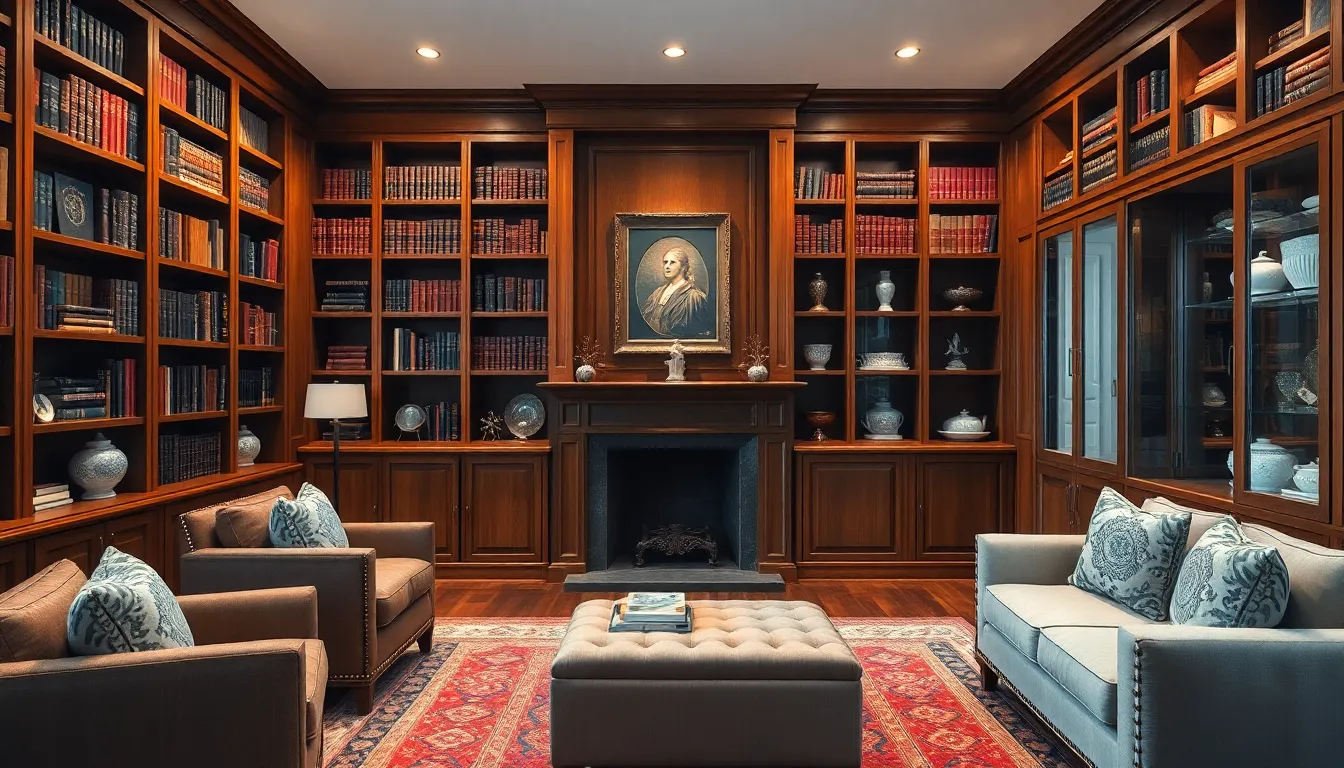
Built-in storage answers seamlessly blend functionality with traditional aesthetics while maintaining the classic elegance we’ve established throughout our living room design. Custom cabinetry integrates with existing architectural elements to create organized spaces that showcase our treasured collections without compromising the room’s sophisticated character.
Traditional Library-Style Bookcases
Library-style bookcases with rich wood finishes serve as defining elements in traditional living room designs. These floor-to-ceiling installations feature crown molding and paneled details that evoke the old-industry charm characteristic of classic interiors. We recommend selecting bookcases with deep, warm wood tones that complement our existing furniture pieces and architectural elements.
Crown molding details add sophisticated finishing touches that connect the bookcases to the room’s overall design scheme. Paneled construction creates visual depth while providing sturdy shelving for our curated book collections and decorative accessories. These installations become striking focal points that anchor the traditional aesthetic we’ve carefully developed through our color palettes and furniture selections.
Curated displays within these bookcases combine leather-bound volumes with carefully chosen decorative objects to create visually appealing arrangements. We suggest alternating books with small sculptures, vintage accessories, and framed photographs to maintain visual interest across the shelving spans.
Display Cabinets for China and Collectibles
Glass-fronted display cabinets showcase fine china, family heirlooms, and collectibles while adding elegant storage answers to our traditional living rooms. These cabinets feature ornate woodwork that complements the rich finishes we’ve incorporated throughout our furniture selections and architectural details.
Internal lighting systems highlight our treasured pieces while creating warm ambient lighting that enhances the room’s welcoming atmosphere. LED strip lighting or small spotlights illuminate displayed items without generating excessive heat that could damage delicate collectibles or antique pieces.
Adjustable shelving accommodates items of varying heights while maintaining organized displays that reflect our personal history and refined taste. We recommend grouping similar items together while leaving adequate space between pieces to prevent overcrowding and allow each item to be properly appreciated.
Hidden Storage Answers That Maintain Style
Hidden storage maintains the uncluttered aesthetic traditional living rooms require while providing practical answers for modern living needs. Built-in benches with lift-up seats offer discrete storage for throws, pillows, and seasonal items while providing additional seating when we entertain guests.
Storage ottomans upholstered in rich fabrics that coordinate with our existing textiles serve dual purposes as footrests and concealed storage compartments. These pieces blend seamlessly with our traditional furniture arrangements while hiding remote controls, magazines, and other everyday essentials.
Paneled cabinet fronts conceal modern electronics and equipment behind facades that match our room’s traditional woodwork and architectural details. We can integrate these answers into existing built-in installations or create new cabinetry that appears to be original architectural elements rather than afterthoughts added to accommodate contemporary needs.
Add Traditional Flooring and Area Rugs
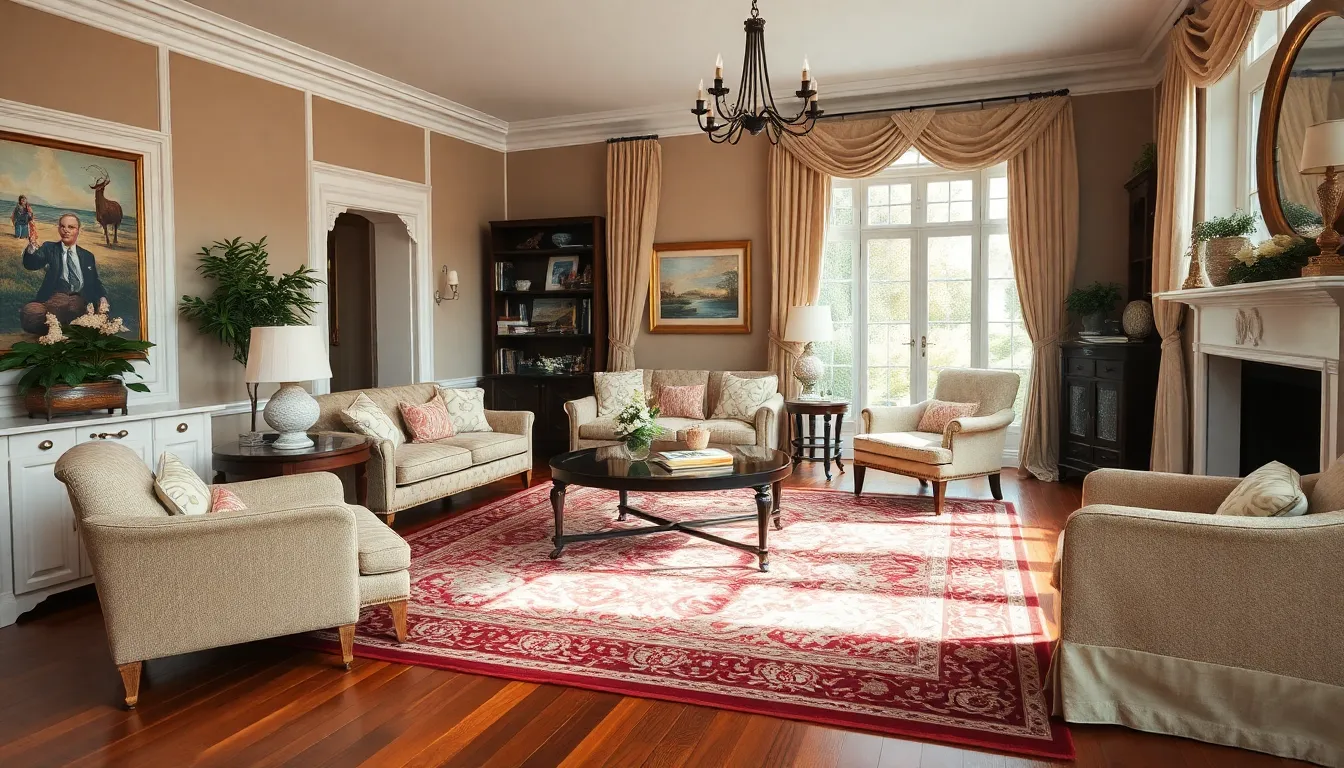
Floor treatments form the essential foundation for our traditional living room design, establishing both visual warmth and timeless elegance throughout the space.
Hardwood Flooring Options
Hardwood flooring serves as the quintessential choice for traditional living rooms, providing durability and classic appeal that never goes out of style. Oak remains the most popular selection due to its strength and beautiful grain patterns that complement various traditional design elements. Walnut offers rich chocolate tones that pair beautifully with deeper color palettes we’ve discussed, while mahogany brings luxurious reddish hues that enhance the sophisticated atmosphere.
We recommend selecting wide plank flooring to emphasize the traditional character of your space. Natural finishes showcase the wood’s inherent beauty and allow the grain patterns to become decorative elements themselves. Distressed or hand scraped textures add authenticity and complement the weathered furniture pieces that define traditional style.
Classic Persian and Oriental Rug Patterns
Persian and Oriental rugs introduce sophisticated warmth and visual interest that hardwood floors alone cannot provide. Herati patterns feature repeating fish motifs that create subtle movement throughout your living space. Kerman designs showcase intricate floral medallions that serve as artistic focal points beneath seating arrangements.
Tabriz rugs offer geometric patterns that complement the symmetrical layouts characteristic of traditional design. We suggest selecting rugs with rich jewel tones that echo the deep colors you’ve incorporated into your overall palette. Traditional patterns like these have adorned elegant homes for centuries, making them perfect investments for your timeless living room.
Hand knotted construction ensures these rugs will maintain their beauty and value over decades of use. Persian wool provides exceptional durability while developing a beautiful patina that enhances the traditional aesthetic we’re creating.
Coordinating Floor Treatments With Overall Design
Coordinating your flooring and area rugs requires careful consideration of your established color palette and design elements. Dark hardwood floors create stunning contrast when paired with light colored Persian rugs, drawing attention to both the beautiful wood grain and intricate rug patterns. Light oak flooring works harmoniously with deeper toned rugs that anchor your seating arrangements.
We recommend selecting rug colors that complement rather than match your upholstery fabrics exactly. This approach creates visual depth while maintaining the cohesive look essential to traditional design. Consider how your rug patterns will interact with wallpaper designs and textile patterns you’ve already incorporated.
Size matters significantly when coordinating floor treatments with your overall design scheme. Large rugs that extend beneath all major furniture pieces create unity and define conversation areas. Smaller accent rugs can highlight exact zones like reading nooks or fireplace seating areas while maintaining the room’s balanced proportions.
Balance Modern Comfort With Traditional Aesthetics

Traditional living rooms thrive when we thoughtfully blend modern conveniences with classic design principles. Creating this harmony allows us to enjoy contemporary comfort while preserving the timeless elegance that defines traditional spaces.
Integrating Contemporary Technology Discretely
Wall-mounted televisions offer the perfect solution for maintaining traditional aesthetics while accommodating modern entertainment needs. We can position these flat screens discretely above mantels or built-in cabinetry to minimize their visual impact on our carefully curated traditional design.
Smart lighting systems revolutionize how we control ambiance without introducing visible modern devices throughout our living spaces. These remote-controlled systems let us adjust chandelier brightness, table lamp intensity, and accent lighting levels seamlessly to create the perfect atmosphere for different occasions.
Hidden cable management ensures that unsightly wires don’t disrupt our traditional aesthetic. We recommend routing cables through walls or using decorative cord covers that match our existing woodwork to maintain the room’s clean, classic appearance.
Concealed speakers integrated into built-in bookcases or crown molding deliver high-quality audio without compromising our traditional design scheme. This approach allows us to enjoy modern sound systems while preserving the room’s authentic character.
Maintaining Functionality Without Sacrificing Style
Layered lighting combinations provide both practical illumination and atmospheric warmth through strategic placement of chandeliers, table lamps, and candles. We can achieve optimal functionality by incorporating multiple light sources that serve different purposes while maintaining our traditional aesthetic.
Practical seating arrangements ensure everyday comfort without abandoning classical principles. We recommend selecting upholstered pieces with modern support systems hidden beneath traditional fabrics like velvet or leather to create the perfect balance of style and comfort.
Storage ottomans serve dual purposes by providing hidden organization space while functioning as additional seating or footrests. These versatile pieces integrate seamlessly into our traditional design when upholstered in coordinating fabrics or rich leather finishes.
Flexible furniture layouts accommodate both formal entertaining and casual family gatherings through thoughtful placement of lightweight accent chairs and side tables. We can easily rearrange these pieces when needed while maintaining the room’s overall symmetrical balance.
Creating Conversation Areas That Encourage Gathering
Symmetrical seating arrangements foster natural conversation flow through mirrored layouts and wrap-around configurations that create calm, welcoming atmospheres. We can achieve this balance by positioning matching armchairs across from our primary sofa to establish clear conversation zones.
Cozy den configurations incorporate varied tactile elements like weathered leather furniture, plush throw pillows, and soft area rugs to encourage gathering and intimate discussions. These elements work together to create inviting spaces where family and friends naturally want to spend time.
Circular furniture formations arranged around focal points like fireplaces or coffee tables help easy conversation among multiple guests. We recommend maintaining comfortable walking paths between seating groups while ensuring everyone can see and interact with others in the space.
Rounded furniture pieces with soft edges enhance comfort and warmth while promoting the flowing conversation that defines successful traditional living rooms. These gentle curves create more approachable seating areas compared to angular modern designs, encouraging guests to relax and engage naturally.
Conclusion
Creating a traditional living room that balances timeless elegance with modern functionality isn’t just about following design rules—it’s about crafting a space that feels genuinely welcoming for years to come. We’ve explored how the right combination of classic elements can transform any living area into a sophisticated retreat.
The beauty of traditional design lies in its adaptability. Whether you’re starting from scratch or updating an existing space we’ve shown you how to blend rich textures luxurious fabrics and statement pieces while maintaining the comfort your family needs.
Remember that successful traditional design isn’t about perfection—it’s about creating harmony between classic aesthetics and your lifestyle. By thoughtfully incorporating these elements you’ll develop a living room that serves as both an elegant entertaining space and a comfortable daily retreat for your household.
Frequently Asked Questions
What defines a traditional living room design?
A traditional living room features timeless elegance through rich wood finishes, plush fabrics, and classic color palettes. These spaces emphasize symmetrical arrangements, quality materials like leather and linen, and refined elements such as ornate lighting fixtures and formal artwork. The design creates a welcoming environment suitable for both formal entertaining and casual family gatherings.
What color schemes work best for traditional living rooms?
Traditional living rooms thrive with rich earth tones and deep jewel colors like burgundy, forest green, and sapphire blue that add depth and sophistication. Timeless neutral combinations such as cream and taupe provide versatility for various occasions. These color palettes create a warm foundation that complements classic furniture and decorative elements.
How should I arrange furniture in a traditional living room?
Arrange furniture in symmetrical groupings to promote conversation and maintain balanced layouts characteristic of traditional style. Start with a comfortable plush sofa as the room’s anchor, add matching armchairs, and position classic wood coffee tables centrally. This arrangement creates visual harmony while ensuring functionality for gatherings and daily use.
What types of lighting fixtures complement traditional design?
Crystal chandeliers and traditional pendant lights with ornate designs serve as elegant statement pieces. Complement these with matching pairs of table lamps featuring classic shades for task lighting and symmetrical balance. Add sconces for ambient lighting to highlight architectural features while maintaining the warm, inviting atmosphere essential to traditional spaces.
How can I incorporate modern technology without compromising traditional aesthetics?
Integrate contemporary technology discreetly through wall-mounted televisions and smart lighting systems that blend seamlessly with traditional elements. Use hidden cable management and concealed speakers to preserve the classic appearance. Choose technology solutions that can be tucked away or disguised within traditional furniture pieces and cabinetry.
What flooring options work best for traditional living rooms?
Hardwood flooring in oak, walnut, or mahogany provides durability and classic appeal perfect for traditional spaces. Wide plank flooring with natural finishes enhances the traditional character. Complement hardwood floors with Persian or Oriental rugs featuring rich jewel tones and intricate patterns that add warmth and sophistication to the space.
How do I select the right area rugs for traditional living rooms?
Choose Persian or Oriental rugs with rich jewel tones and intricate patterns that complement your established color palette. Ensure the rug size defines conversation areas and creates visual unity within the room. The rug should coordinate with other traditional elements while adding warmth and texture to hardwood or classic flooring.
What are essential furniture pieces for a traditional living room?
Essential pieces include a comfortable plush sofa as the room’s foundation, matching armchairs or aged leather chairs for layered seating, and classic wood coffee tables with elegant carved details. Add antique accent pieces like ornate mirrors, traditional lighting fixtures, and quality storage solutions that blend functionality with sophisticated traditional aesthetics.







